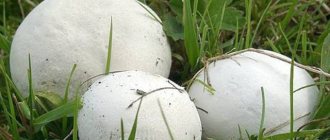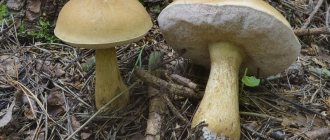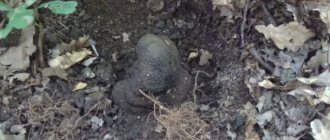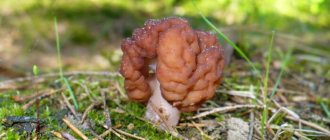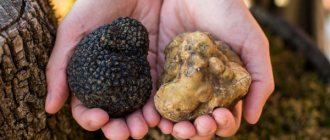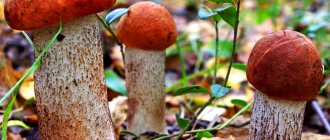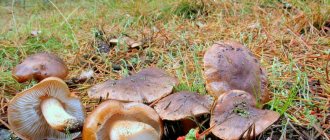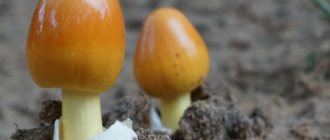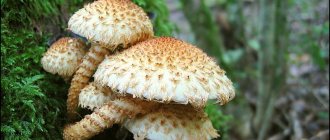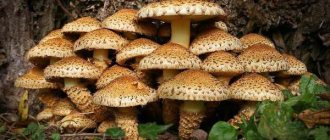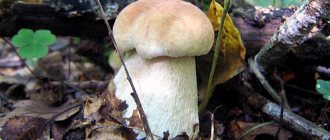Simanov Kiril Petrovich
A mushroom picker whose basket contains many types of mushrooms
Alder moth. There are mushrooms that are similar in appearance to one of the popular edible mushrooms, and grow at approximately the same time, and are found in almost the same places. An inexperienced mushroom picker, having encountered such a double, risks making a serious mistake and dragging home full baskets of completely inedible rubbish with a joyful face. One of these unpleasant pretenders is the alder moth. Of course, an experienced quiet hunter will not be deceived by the firebug, but beginners should carefully study the description of this species so as not to be deceived by it. Eating this mushroom will not lead to any terrible consequences. However, stomach upset, vomiting and diarrhea can also cause quite a lot of trouble.
— Simanov Kiril Petrovich Mushroom picker, whose basket included many types of mushrooms
Alder scale, Pholiota alnicola
Hat:
In youth, hemispherical, then simply convex, eventually becoming almost prostrate. Diameter 4-6 cm. Color yellow-lemon, with rare scales of almost the same color (therefore they are not visible), the surface is sticky and shiny. The pulp is yellowish, without any particular smell, the taste is bitter.
Hymenophore:
The plates are frequent, adherent, lemon-yellow in youth, and darken as the spores mature. When young, they are covered with a white cobwebby veil, which, as a rule, does not leave a noticeable ring.
Spore powder:
Brown.
Leg:
Height 5-10 cm, thickness 0.5 - 1 cm, cylindrical, dense, in the upper part - the same color as the cap or even lighter, darker at the bottom due to numerous scales.
Spreading:
Pholiota alnicola is found in August-September on the remains of deciduous trees (it especially loves alder and birch), as well as on the soil near them. Can form large colonies.
Similar species:
You should immediately discard the sulfur-yellow honey fungus (Hypholoma fasciculare), which is similar to this scale only in its growing conditions. There are many more differences, including a dominant sulfur tint and darker plates. In general, it is not difficult to distinguish this flake from other representatives of the genus Pholiota: the pine flake (Pholiota spumosa) grows on pine stumps, and the cap of the fire flake (Pholiota flammans) is completely covered with large scales.
Update: According to Kourtekis, there are a number of very closely related species of yellow scales:
1. Pholiota alnicola – the ancestor of the “alder” series. It is distinguished by a strong aromatic odor and a pronounced cortina, which turns brown from the base. Cortina is clearly visible on its yellow leg. The largest in the group. Prefers alder. 2. Pholiota salicicola – a small “willow” version of alnicola that has no odor. 3. Pholiota flavida – a lighter version, odorless, growing on conifers. 4. Pholiota apicrea – a more powerful and pale-colored version, characterized by a strong cinnamon scent at the base of the stalk. 5. Pholiota pinicola is a separate species, more brownish-red in color, with a slightly pronounced cortina and a weak odor. Prefers pine.
Edibility:
It is said that Pholiota alnicola is considered an inedible mushroom due to its bitter taste - as, in fact, do most flakes. And, along with the majority, it is considered completely groundless.
Author's notes:
In July I found the first one, on a linden tree: it looked out from a crack in the bark at the height of my height and looked like a flashlight. I really liked it right away, although, to be honest, I didn’t understand it well. And in August they climbed. One week (towards the end of the month) it was difficult to find a place in the forest from where not a single colony of this wonderful mushroom could be seen. The forest was dotted with bright lemon-yellow spots. It’s not very often, by the way, that mushrooms show us such pure colors.
But, to be honest, I never thought of trying alder flakes. It goes without saying that this mushroom is inedible. Like many things that are so pleasant to eat with your eyes.
It doesn’t change from year to year: in the hot summer of 2005, the alder scales looked timid and even somehow pitiful. However, almost all the other mushrooms didn’t look like anything at all - they weren’t there, they weren’t there at all.
The mushroom is so photogenic that it was impossible to stop taking pictures. It’s a pity that we won’t see the most important thing: namely, a huge oak stump, all covered with young tufts of alder scales. The film has run out.
Alder flake is one of the most lemony mushrooms I have ever seen. Lemon cap, lemon leg, lemon leaves. only the private bedspread seems to be white. White and cobwebby. Looking at this picture, it becomes more or less clear why scales were previously classified as cobwebs.
Time spares no one, especially mushrooms. And even the bright, airy alder flake, which charges the inhabitants and guests of the forest with irrepressible optimism, at the end of its life path becomes dull and lethargic.
Not to say that we are looking at old, withered specimens, formed in unnatural conditions. This scaly strives to save face at any cost, and most often it still succeeds.
It seems that such an attractive mushroom must be edible and tasty. Oh, if only they prepared it - the autumn honey mushroom would have to rest nervously! Maybe it is for this reason that alder flakes have no practical value. Smart of her.
Taxonomy
Synonyms
- Agaricus alnicola Fr., 1821
- Agaricus alnicola var. salicicola Fr., 1838
- Agaricus amarus Bull., 1782
- Agaricus apicreus Fr., 1838
- Dryophila alnicola (Fr.) Quél., 1886
- Flammula alnicola (Fr.) P.Kumm., 1871
- Flammula alnicola var. salicicola (Fr.) P.Karst., 1879
- Flammula apicrea (Fr.) Gillet, 1876
- Gymnopilus alnicola (Fr.) Murrill, 1917
- Pholiota amara (Bull.) Singer, 1975
- Pholiota apicrea (Fr.) MMMoser, 1967
- Pholiota aromatica P.D.Orton, 1960
- Pholiota salicicola Bon ex Arnolds, 1983
Types of flakes
The genus of scales has about 150 species, of which about 30 grow in the forests of Russia. The most common types are foliots: ordinary, golden, fiery, cinder, alder, gum-bearing, destructive, edible (hint).
Common scalyfoot
This is the most common type. Mushrooms of this type are also called fleecy, scaly, dry. They grow in colonies on the wood of living and rotten deciduous trees. The caps have a diameter of 6-10 cm; in young ones they are hemispherical in shape, in mature ones they are flat. The surface of the caps is pale yellow with pronounced orange-brown scales.
The leg is cylindrical, dense, rusty in color. Young specimens have a veil that breaks when ripe, forming a ring on their stem and flakes along the edges of the cap.
The pulp of this species is fleshy, white or yellow in color, although edible, it tastes bitter.
Golden scale (royal honey mushrooms)
The golden species is one of the largest representatives of foliots: the diameter of the cap can reach 18 cm. Their fruiting bodies are painted in a bright yellow, golden color. The surface of the cap is covered with mucus and small dark brown scales. In young specimens, the cap has a hemispherical shape with tucked edges; in adulthood, it has a saucer shape with a convex center.
Fire scale
This is an inedible species of foliot. Mushrooms of this species are smaller in size than ordinary or golden ones: the diameter of the caps does not exceed 7 cm. The caps are painted in reddish tones and covered with thick curled scales of a lighter color than the cap. The scales on the cap form a pattern of ovals. The pulp is fleshy, hard, yellow in color, becomes brown when broken, has an astringent bitter taste and an unpleasant odor, so it is not eaten. They bear fruit from mid-July to the end of September.
Cinder flake
Cinder flake is also called coal-loving. The caps of this species of mushrooms are often stained with soot and dirt, since their favorite places to grow are burnt trees and fireplaces. Soot, dust and dirt stick to the mucous surface of the caps, so the mushrooms quickly become dirty yellow or dirty brown. In young foliots, the caps are covered with a private veil; in mature ones, the remains of this veil are preserved in the form of a ring on the stem and along the edges of the cap. The legs are covered with small reddish scales. The pulp of these foliots is dense, hard, light yellow, and has no specific taste or smell. There is no information in the literature about the edibility of these mushrooms. They grow from August to October.
Alder scale
These foliots are also called alder moth. They are often found on stumps and alder or birch wood. The size of the firefly caps is small: does not exceed 5-6 cm. The color of the caps is yellow-orange, along their edge there are flake-like remains of a private blanket. The legs are curved and have a pronounced ring. Below the rings are fibrous, above the rings are smooth.
The pulp of the mushrooms is yellowish, dirty yellow, inedible. If eaten, moths can cause poisoning. They bear fruit in August-September.
Gum scale
These mushrooms are also called yellow-green because their fruiting bodies, covered with scales, range in color from light yellow to yellow-green. The diameter of the caps of gum-bearing foliots is 3-6 cm. The pulp is edible because it does not have the rare taste and smell specific to flakes.
Destroying scale
These mushrooms are often found on old and dry poplars, so their second name is foliota poplar or poplar. These fungi actively destroy the wood of the tree during their growth. The caps can reach 20 cm, are colored light brown or yellowish, and covered with white scales. The legs are thinned towards the apex and have swellings at the base. The legs match the caps in color and are also covered with scales.
Edible scale
This type of foliot is industrial. Mushrooms of this species are cultivated on a large scale in Japan and China. Their second name is foliota or nameko honey fungus. Grown in rooms with high humidity - 90-95%. They grow in groups. The sizes of these mushrooms are small - no more than 2 cm in diameter. The color of the fruiting bodies is orange-brown, the surface is covered with thick, dense jelly-like mucus.
They have soft flesh, similar in taste and smell to real honey mushrooms. On the shelves of our stores you can often find pickled edible flakes made in China. Only the inscription on the jar says that it is honey mushrooms (the second name for edible scales). Pickled foliots differ from real honey mushrooms by their mucous marinade, which is due to the jelly-like coating of the caps of the latter.
Spread of root rot
The spread of fungi - pathogens of rot - and infection of plants occurs by spores when they get on the stumps, roots, root collar of the trunk, as well as by mycelium and its various modifications (films, rhizomorphs) when the roots of diseased trees come into contact with healthy ones. Due to the spread of infection through the roots from tree to tree, the plantings dry out in groups (clumps).
Damage to the roots causes a sharp disruption in the supply of nutrients and water to the above-ground parts of plants - trees relatively quickly weaken, dry out and are often subject to windfall.
In forest and artificial plantings, root rot damage can become widespread, covering large areas. Widespread occurrence of root rot occurs in plantings experiencing high recreational pressure, which creates conditions that contribute to the weakening of plants, reducing their biological stability, increasing the likelihood of mechanical damage to roots and trunks and infection with root rot.
Root rot
The main sources of root rot infection are infected stumps. The most common pathogens of root rot of woody plants are:
- root sponge,
- autumn honey fungus,
- Shveinitsa tinder fungus (felt-brown tinder fungus),
- flat tinder fungus.
Popular articles Hygrofor olive-white
What kind of miracle beast is this?
In ancient times, people told each other all sorts of fables, and sometimes true incidents from life. Then these stories were passed down from generation to generation, acquiring many different facts. So, there are also rumors and legends about the fire snake. Siberians say that this terrible beast can jump up from the ground by more than one and a half meters and bites its victim exclusively in the neck or chest area.
And many residents of the northern regions of Russia claim that moths can hang on trees to make it more convenient to attack their prey. Moreover, in addition to people, their prey can also be cows, on which snake moths descend from the trees. The bite of such reptiles can be fatal to humans, because, as was written above, such a snake stings in the neck or chest area. From there, a person is not able to suck out the poison on his own, and the situation with a bite does not tolerate delay. By the way, if you take the necessary measures in time (injection or at least suction of the poison), then it is quite possible to avoid negative consequences.
In cooking
Golden flake belongs to the 4th category of nutritional value, however, most lovers of mushroom cooking note its high taste and pleasant, mushroom aroma. The mushroom tastes like white mushroom, and when fried it even surpasses it.
The use of royal mushrooms in cooking is universal. Thanks to the texture of the pulp, which retains its density during cooking, it is suitable for all types of culinary processing: boiled, fried, stewed. Based on this, there are many recipes for golden flakes.
This mushroom is used to prepare soups, main courses, stews, salads, fillings for pies, pies, pizza, etc. It has shown itself well, both as a monocomponent and in combination with other ingredients. Pairs perfectly with meat, vegetables and especially fried and stewed potatoes.
Advice! The taste of fried and stewed golden flakes is especially fully revealed when milk or sour cream is added.
Literature:
Polenov A.B. Great encyclopedia of mushroom picking. We collect and prepare.
M.V. Vishnevsky. Medicinal mushrooms. Great encyclopedia
Legend
In Siberia, among local residents there is one strange legend, in which hunters and old-timers firmly believe. It concerns the killing of snakes, namely, that if a person is lucky enough to deal with a dangerous reptile, then his sins are forgiven.
We are talking about a fairly large number of sins per hunter, namely 40. Whether this is true or not - everyone decides for himself. But people protect their lives in a cold, harsh region with particular passion (one hunter or forester can kill about 40 poisonous individuals in a day), as evidenced by data reported in the media. Such facts are not surprising, since more than 10 million snakes have been registered in Siberia. However, I would like to note that no one has yet provided either the skin or a photo of the moth snake in Siberia.
Fire snake: photos and descriptions of several individuals
The moth got its name from the color it is endowed with. Those who claim to have seen it live talk about three varieties of these reptiles, dangerous to humans and livestock:
- The first type of reptile is coal-black with a flattened head and two long teeth in its mouth. Sometimes, however, there may be bright red dots on her head.
- The second species is the fire snake, a photo of which is not so easy to find. It is a red reptile. This is the most dangerous and most poisonous snake of all subspecies. Its scales are uniformly colored red-burgundy, without transitions or divisions in the area of the head and tail, but on it you can see a kind of woven pattern in the form of equivalent diamonds.
- Well, the third description of the fire snake, compiled from the words of eyewitnesses: a black-red reptile, which seems to have its entire body shaded with red thin stripes.
It is worth saying that the moth is not called a huge snake; it is more similar in size to a copperhead or viper. In general, not very big.
Spreading
Wood-decaying fungi mainly reproduce by spores, which are produced in large quantities in fruiting bodies. Spores are spread through the air, rain, insects and other means. They penetrate into tree tissue through damage to trunks, branches and roots - peeling, nicks, nicks, scuffs, cancerous wounds, as well as through saw cuts or broken branches. In these places of primary infection, the fruiting bodies of pathogens are subsequently formed. The high ability of xylotrophs to form spores is very dangerous for plantings.
In addition to spores, the infection can spread in the form of mycelium and its modifications, including mycelial films and rhizomorphs. The latter are dark brown, almost black, cord-like, branching plexuses of mycelium. Characteristic films and rhizomorphs are formed in the autumn honey fungus.
The development of rot in the affected organs occurs only if the wood substrate meets the requirements of the pathogen for humidity, temperature, mineral nutrition, and acidity of the environment.
Phases of development of the moth on currants
The beginning of the butterfly's flight depends on the weather and average daily air temperatures. Usually it coincides with the budding phase and the beginning of flowering of early currant varieties.
Five to seven days after departure, the moths lay eggs in flowers. One female can lay up to two hundred eggs. The summer of butterflies lasts two to three weeks. The eggs of the moth are white, oval, about 0.75 mm in size. The butterfly lays its main eggs inside the flowers. The future moth develops in the egg for about one week. Newborn caterpillars are whitish-yellowish, two to three millimeters long, with a black head.
Only one caterpillar feeds in one ovary, regardless of how many eggs were laid. “Extra” individuals crawl into neighboring ovaries.
The hatched caterpillars begin to devour seeds and berries, enveloping them in webs. Each of them eats up to fifteen currants or 5–7 gooseberries. The color of adult caterpillars is bright green, the head is black. They reach 18 mm in length.
Moth caterpillar
The lifespan of a moth in the form of caterpillars before pupation varies and depends on the weather and the type of plant—the “feeder.” On gooseberries, development proceeds faster. On blackcurrant, the growth of caterpillars is delayed for one and a half weeks and lasts 22–30 days.
Each individual, having completed the next stage of development, descends to the ground along the web, deepens 5–6 cm and pupates. Moth pupae are located in groups of 5–7 in the top layer or on the surface of the ground under debris, fallen leaves, clods of soil within a radius of no more than forty centimeters from the bush.
On currants, the moth prefers varieties that bloom profusely during its mass summer. If spring is early and warm, these are the early varieties Sevchanka, Selechenskaya and others. At low spring temperatures - Lazy, Veloy, that is, late varieties.
✎ affiliation and generic characteristics
Scale (lat. Pholiota) or foliota is a common genus of mushrooms from the strophariaceae family (lat. Strophariaceae), order agaricaceae (lamellar) (lat. Agaricales).
Sometimes other types of mushrooms are also called flakes, from the genus vole (or field grass) (Latin Agrocybe), which belongs to the same family of strophariaceae.
Scaly mushrooms got their name from the “scaly robe” of the fruiting body, in the form of many small scales that completely cover the cap and stem of the fruit.
Nowadays, open sources indicate a different number of species of such mushrooms, usually about 150; in Russia, about 30 of them are found, most of which are considered inedible because of their bitter taste, and some are considered edible, like the Far Eastern species - scaly edible (lat. Pholiota nameko) (though it is rare in nature, but is well cultivated), the rest are conditionally edible, with taste qualities comparable to honey mushrooms.
Among the flake mushrooms there are also those that are dangerous pests of the national economy (parasites of living trees and destroyers of wooden buildings). But perhaps the most important thing is that among the flake mushrooms there are no poisonous species (except for the mixed flake (lat. Pholiota mixta), which, According to various sources, it contains few toxins, therefore it is considered mildly poisonous)
This means that for those who collect flakes there is no danger of making a mistake and running into a poisonous or, God forbid, deadly poisonous specimen (as with spider web mushrooms, in the genus of which there are also such ones). Interest for mushroom pickers in Russia and some former republics of the USSR, very few can call,
edible ones are:
which is typically cultivated (in large quantities) mainly in China and Japan (its Japanese name is "nameko" or "nameko mushroom", which means "slippery mushroom" because it is completely covered with a very slippery jelly-like substance).
But not only there, in the Russian Far East, too, where it grows in conditions of high humidity (90% - 95%) on stumps or fallen trees of broad-leaved trees (for example, beech), like honey mushrooms, and is used to make miso soup,
of the conditionally edible ones, these are:
all of which, due to the content of a small amount of bitterness in the pulp, or due to the mucous-sticky surface of the fruiting body, were classified as conditionally edible. But it should be noted that in terms of taste and nutritional qualities they are not much inferior to honey mushrooms, and many mushroom pickers prefer flake mushrooms to the more famous honey mushrooms, which are definitely edible mushrooms.
And there are already more flake mushrooms in this genus that are unsuitable for consumption:
of the inedible ones are:
of the inedible, the population of which is low in number or poorly distributed, or with poorly studied nutritional qualities, these are:
- yellowing flake (moth);
- saffron-red flake;
- white scale;
- multicolored scale;
- flake deviating (birch);
- pine flake;
- bow-legged scale;
- the scales are thick,
from inedible ones containing weak toxic substances, these are:
which, due to the suspicion of containing mild toxins, is classified in the section of inedible mushrooms with mildly poisonous properties.
Alder scale (lat. Pholiota alnicola) is a little-known cap-footed, inedible species of the genus Pholiota (lat. Pholiota), from the family Strophariaceae (lat.
Strophariaceae) and the order agaricaceae (lamellar) (lat. Agaricales).
Alder scale received its name for the scaly surface of the fruiting body, the epithet “alder” - for its ability to grow in warm floodplain forests on alder trunks or on its rhizomes, as well as on the soil next to them.
Alder scale is far from the most common among the species of its family. Some sources classify it as a poisonous mushroom, while others classify it as inedible.
Who to believe? If we take into account the fact that alder flake is not much different from all other flakes and does not contain any toxins at all, but only has a bitter aftertaste, then it should be rather an inedible (or unsuitable for food), but not a poisonous mushroom.
How to store
Golden scale is a universal mushroom. Thanks to its fleshy, dense, elastic pulp, it has proven itself well in all types of preparations. The least troublesome way to preserve them after harvesting for use out of season is by drying, in which you do not need to pre-wash and boil the mushrooms; just clean them of debris with a sponge or toothbrush.
To ensure that the fruiting bodies are dried evenly, they are selected of the same size, large specimens are cut, strung on a thread and dried in the open air. You can also use an oven, stove or electric dryer for drying. With this method, the maximum beneficial properties of mushrooms are preserved.
Attention! Mushrooms collected from coniferous trees may be slightly bitter. Experts recommend using them for winter preparations.
Also, the edible golden flakes are frozen and thereby obtain a semi-finished product, immediately ready for the main culinary processing. The taste and delicate texture of these mushrooms are most fully revealed when salted and pickled.
Information! The product is low-calorie. Calorie content is 22 kcal per 100 g.
Alder moth
Walking through the autumn forest in search of a harvest, inexperienced followers of quiet hunting may well confuse these mushrooms with honey mushrooms. And it’s not even that the alder moth is similar in appearance to honey mushrooms, but it also grows on trees and stumps in entire colonies, and even their fruiting period coincides.
And in this similarity lies its danger, because such a find is completely unsuitable for food, so it is very important to be able to recognize this mushroom
Alder moth
Alder moth - lat. Pholiota alnicola
The moth is also called alder flake. This mushroom belongs to the strophariaceae family and the genus Squamosidae.
Mushroom cap
Young moths have dense spherical caps that are attached to short and completely invisible legs. As they get older, the moths' caps transform into a cone-shaped shape. And by the peak of ripening, the caps become flat-convex with a curved edge, similar to saucers and can reach a diameter of up to 6 cm. From a young age, these mushrooms have a bright yellow-ochre, lemon color, which becomes even more intense as they grow.
On the outside, the cap of the moth is covered with tiny scales that match the main color of the mushroom, which makes them completely invisible. Only upon closer inspection can these layers be seen. Moreover, despite the humidity, the moth's cap always remains slimy and sticky.
But along the edge there are thin flakes - the remains of a filmy blanket - visible to the naked eye. They are usually white or brownish in color.
On the inside, the cap of the scale has frequently set thin plates called hymenophores. Their color is yellow, but by the time the spore sacs mature, the plates darken and acquire a rusty or brown tint.
Stipe
The leg of the moth is curved, elongated and quite thin - from 3 to 10 cm in length and 0.5 cm in diameter. Old mushrooms have a hollow stem. It has a fibrous texture and a white coating, but not uniform. Above the ring, which disappears over time, the surface of the leg is smoother and lighter. And below the ring it is fairly fibrous and dark – brown.
Alder moth - lat. Pholiota alnicola
Place of growth
As the temperature change becomes more apparent closer to autumn, moths begin to appear in the forests. High humidity is the most optimal environment for them. Therefore, the culmination of their growth occurs precisely during the autumn rainy season. These mushrooms grow in large groups on dead alder and willow wood. You can rarely see alder scale on oaks and beeches.
The alder moth has a very wide growing range and therefore can be found both in Primorye and in the European regions of the Russian Federation, as well as in the south.
Typically, parasitic colonies of moths settle on fallen deciduous trees. However, mushrooms often spread along the ground near the woody “donor”.
Edibility of the mushroom
Externally, alder flake is very attractive. The bright yellow color, neat shape, and pleasant sweetish smell often serve as a sign of a good harvest for inexperienced mushroom pickers. However, this mushroom tastes very bitter and is generally unsuitable for food.
Despite the low degree of toxicity, eating flakes can still lead to poisoning. Pickled or salted alder moth is considered especially dangerous, since vinegar and salt increase the concentration of poisons by 2-3 times.
Similar types and differences from them
It is not at all difficult to confuse alder moth with honey mushrooms. These mushrooms are not only very similar in appearance, but also their ripening and growth times are the same. However, there are a couple of criteria by which you can identify an unsuitable mushroom:
- Honey mushrooms grow near coniferous forests, mainly on the “remains” of coniferous trees. But the moth feels at ease only in deciduous windbreaks.
- You can also distinguish honey fungus from moth by the ring. Honey mushrooms have a more pronounced and dense ring on the legs.
Fire alder or alder flake can cause poisoning for unscrupulous mushroom pickers. And to avoid this, you need to learn to distinguish a poisonous mushroom from edible and tasty honey mushrooms.
Gymnopil Juno
Some types of mushrooms are easily confused with inedible and even hallucinogenic mushrooms. Such undesirable trophies include the Gymnopil of Juno, which sprinkles stumps just as cheerfully as honey fungus, but is completely unsuitable for food.
Gymnopil Juno
Gymnopilus junonius - lat. Gymnopilus junonius
In other sources, this mushroom is called Gymnopilus prominent or Gymnopilus Juno.
Description
Mushroom cap
Gymnopilus Juno grows a large cap: at a young age it grows about 25 mm in diameter, in maturity it reaches 150 mm. At first, the hat has the shape of a hemisphere, but over time it expands, either retaining or not retaining a non-sharp mound in the middle. Large hats often have recesses, and their edges curve upward in a wave-like manner.
Popular articles Govorushka smoky form white
The cap skin, covered with many small adjacent scales, is painted in a rich yellow, yellow-ocher or yellow-orange hue. The scales are colored to match the hat. During the rainy season, the color of the caps appears darker, and during dry seasons, the color appears lighter.
The “headdresses” are filled with tight, fleshy light yellow pulp, which turns brown in old mushrooms.
The hat bottom consists of wide, frequent plates of a bright yellow hue, which, as they mature, become brownish-yellow, reddish-brown or dark orange.
Gymnopil Juno reproduces with yellow-red warty elongated spores located in red-brown spore powder.
Stipe
The mushroom stalk reaches 8-35 mm in thickness and 30-200 mm in height, and has a thickening in the middle or at the bottom. It is filled with tight fibrous pulp.
The leg surface of Gymnopile prominent is distinguished by a yellow-brown color and often blends in with the color of the hat. The bedspread leaves a narrow filmy ring, which, drying out over time, leaves behind a brownish belt.
Places of growth
These mushrooms are favored by oak and mixed forests, as well as tree stumps. Capable of parasitizing on the trunks of living trees.
The mushroom rarely grows alone and bears fruit in friendly families throughout the Russian territory, except for zones with a northern climate. Fruiting occurs between July and November.
Edibility of Gymnopyla Juno
The bitter pulp of Gymnopylus Juno with its characteristic bitter almond aroma makes it inedible, although not poisonous. It is classified as a hallucinogenic mushroom containing large amounts of psilocybin, hispidin and steryl pyrones - strong psychedelic components that intoxicate the body, affect the nervous system and cause visual hallucinations.
Especially a lot of psychedelic substances are found in mushrooms growing in the Far Eastern forests.
Similar types and differences from them
Inedible
Herbaceous scale. Unlike gymnopilus, it cannot grow on wood - only on the ground, and is much larger in size. Her hat and foot are strewn with grainy powder.
Edible
- The flake is edible. Unlike Gymnopilus, which is visible with an always moistened cap, the cap of the edible scale remains matte and dry, is painted in an ocher-yellow hue and is covered from below with fleshy plates. This mushroom chooses willow trees for development and fruiting.
- The scales are golden. It differs from Gymnopilus Juno in the absence of a ring on the legs, as well as in pronounced dark scales.
Along with scales, beginning mushroom hunters collect gymnopiles instead of edible mushrooms, since they are very similar in appearance and can also grow on stumps. But honey mushrooms have a strong mushroom aroma, they are not bitter in taste, they are filled with white, tight pulp and covered with many tiny brown scales.
Symptoms of poisoning, first aid
Cases of poisoning by alder flake are extremely rare; the fruiting body should not be consumed in any form. In case of intoxication, symptoms appear after 2 hours and gradually increase:
- mild nausea;
- then the headache begins;
- the symptoms are accompanied by continuous vomiting;
- there is pain and pain in the stomach, sweating;
- Diarrhea complements the signs of poisoning.
Possible increase in body temperature. If measures are not taken in a timely manner, the body faces dehydration and complications in the kidneys, heart or liver. It is impossible to remove toxins from the body at home; you must contact the nearest medical facility or call an ambulance. Before providing qualified assistance, you can alleviate the symptoms:
- Make a weak solution of manganese and wash the stomach.
- Accept sorbents: white or activated carbon, “Polysorb”.
- You cannot stop diarrhea if the symptom has not yet appeared by drinking laxatives or washing the intestines with a manganese enema.
- If you feel chills, take a hot bath or wrap yourself in a blanket.
FAQ
What other names are typical for psilocycin?
Psilobicin mushrooms are also called magic mushrooms, magic mushrooms, just mushrooms, boomers, little smoke mushrooms, Mexican mushrooms, flesh of the gods, ombrecitos. When psilocycin mushrooms are used simultaneously with methamphytamine or ecstasy, the mixture is known as flower powder or hippyflip.
What are the short-term and long-term side effects of using magic mushrooms?
Short term effects include:
- stomach ache,
- diarrhea,
- vomiting
- hallucinations of moderate or moderate severity,
- numbness of the lips, tongue and mouth,
- sweating,
- dizziness.
It is also possible to develop a panic attack, impaired thinking, and anxiety.
Long-term side effects include:
- persistent hallucinogen perception disorder,
- induced psychosis.
Such mental disorders can last for years even after stopping psilocycin use. Patients with pre-existing mental disorders, such as mania, depression, or schizophrenia, may have their symptoms worsened by taking psilocycin.
How addictive are hallucinogenic mushrooms?
As a rule, the use of hallucinogenic mushrooms leads to the formation of persistent habits, rather than pure addiction and dependence. Nevertheless, it is likely that the level of their tolerance will increase, which, in turn, leads to an increase in dosage and the development of psychological dependence.
Who is most likely to use psilocycin?
Typically, the primary users of hallucinogenic mushrooms are teenagers and young adults. The use of magic mushrooms is quite widespread among students, as well as club youth. Currently, there is no specific database that shows the prevalence of psilocycin use in the United States, since hallucinogenic mushrooms are often used together with other drugs. An independent survey conducted by researchers at the University of Michigan found that 9.2% of high school students have tried psilocycin mushrooms at least once in their lives.
Are magic mushrooms a banned substance?
In the United States and some states, the possession and consumption of psilocycin mushrooms is illegal and prohibited. However, the sale of mushroom spores is legal in all states except California, where it is prohibited to buy, sell, import or export mushroom spores.
How are these mushrooms sold?
Psilobicin mushrooms can be found in their natural form, but they can also be sold in dried form or even as a powder. The two main active ingredients in magic mushrooms, psilocinin and psilocin, can be synthesized in the laboratory and sold as tablets, powder or capsules.
How to identify a person who uses hallucinogenic mushrooms?
Popular articles Xeromphalina Kaufman
Signs of using psilocycin mushrooms are similar to those observed with alcohol intoxication and dependence on hallucinogenic psychedelic drugs. Possible symptoms include:
- dry oral mucosa,
- excessive reflexes,
- chills, sweating and trembling,
- nausea,
- vomiting
- dilated pupils,
- lack of coordination
- convulsions,
- excitation,
- disorientation in space,
- urinary incontinence,
- paranoia.
Interesting Facts
Fresh psilocycin mushrooms have a white or gray stem and a brown cap. Dried hallucinogenic mushrooms tend to be rusty in color with white flecks.
Entheogenetic mushrooms such as psilocycin are recognized as sacred in many indigenous structures. Anthropologists have even discovered figurines of mushrooms carved in stone, the creation of which is determined to be 500 AD. Such stone figurines are known as stone mushrooms from the Mayan civilization in Guatemala.
Also read with this material:
First aid for alcohol overdose Barbiturate poisoning Drug addiction: under sleeping pills Harm of beer for women How does cocaine affect the human psyche? Chronic alcoholism Coding as a method of treating alcoholism How to recognize a drug addict Teenage substance abuse How alcohol dependence develops Drugs: the scourge of modern society Cocaine addiction - how to recognize a drug addict The effects of amphetamine Treatment of withdrawal Delirium alcoholism The drug LSD Alcohol and drugs Rehabilitation and recovery for cocaine addiction Signs of use of certain groups of drugs Harm of smoking mixtures
Composition of the detox drug Ognevka for parasites
Safe detox product Ognevka is made from natural raw materials. The composition included:
- bee moth - destroys parasites, has an antibacterial effect, stimulates the growth of immunity;
- propolis - fights fungi, bacteria, parasites. Eliminates intoxication, cleanses the blood;
- fir juice - has an antiviral and antibacterial effect;
- ginger has a detrimental effect on larvae. Stops infection;
- black walnut - cleanses blood and lymph from waste products of parasites;
- cedar resin - has a choleretic effect, inhibits parasites;
- larch - fights intoxication, helps damaged cells recover;
- St. John's wort, dandelion, oak bark, echinacea, horsetail and 9 more plant extracts - enhance the effect of the main components, remove toxins, and have a healing effect on internal organs.
